View of Coronado’s beach shared by motorists, cyclists and pedestrians from the intersection of Marina Avenue and Ocean Boulevard.
In June the City Council unanimously approved funding up to $100,000 for a study of the feasibility of constructing a multi-use path on the beach has become the source of substantial discussion. Vocal opposition to the study caused the City Council to agree to reconsider authorization for the study, which it will do at its September 1 meeting.
Although the opposition has been very outspoken, it does not appear to be universal. City Councilman Richard Bailey conducted an on-line survey to gather resident input. He received 880 responses. While 44 percent of the respondents opposed a multi-use path on the beach, 35 percent supported it, and 21 percent indicated that they needed more information before they could indicate a position. Of note is that 78 percent of all respondents indicated that an evaluation of the ability to improve the existing sidewalk on the beach side of Ocean Boulevard should be made before building a multi-purpose path on the beach.
The purpose of this article is to generate additional debate about the merit of a study and its scope; the pros and cons of a multi-use path on the beach; and the current situation regarding physical and visual access to Coronado’s beach, which is one of the city’s premier assets. Following are two sets of photographs. The first set depicts the current sidewalk on the beach side of Ocean Boulevard, physical and visual access to the beach, and the overall state and appearance of what should be one of Coronado’s finest streets.
These photos should help opponents of the study to better define what they feel is at risk and needs to be saved as implied by the statement on the yard signs “Save Our Beach Coronado” and to express their opinion of the current situation regarding pedestrian and cyclist physical and visual access to the beach and the overall appearance of Ocean Boulevard and what, if anything, should be done about it. The photos should also assist supporters of the study to better articulate its desired scope.
The second set of photographs show how other Southern California communities are addressing cyclists and pedestrians in the context of access to the beaches in their communities and the value that they place on their beaches as evidenced by the improvements and amenities that they have provided for residents and visitors. While what has been done in other communities may not be directly applicable to the situation in Coronado, it may provide inspiration for what could be done to better accommodate the needs of pedestrians, cyclists, as well as motorists and to transform Ocean Boulevard and access to the beach both aesthetically and functionally.
This Tuesday, September 1, the City Council will reconsider its decision to study the feasibility of a multi-use path on the beach. The public is invited to attend this meeting and provide its thoughts to this decision-making. The meeting will take place at 4PM at City Hall. Read a preview of the topics to be discussed here.
Photos of Access to Coronado Beach
Two children riding scooters on the sidewalk between Loma and Flores Avenues demonstrate the inability of the sidewalk on the beach side of Ocean Boulevard to accommodate comfortably and safely two-way pedestrian traffic.
A cyclist on the sidewalk between G Avenue and Marina Avenue shows that the sidewalk adjacent to the “rocks” is inadequate for both bicycle and pedestrian traffic.
Sections of the sidewalk adjacent to the rocks are bounded by unsightly, partially demolished curbing.
Beginning after G Avenue and continuing to the end of the rocks in the direction of North island this is the view of the beach seen by pedestrians and cyclists from the sidewalk and by motorists on Ocean Boulevard.
At its narrowest point the sidewalk is only three feet six inches wide from the face of the rocks to the base of the street light.
A concrete trash container obstructs a portion of the already narrow sidewalk adjacent to the rocks.
The outfall of the storm drain that empties directly on the beach.
The intersection of Isabella Avenue and Ocean Boulevard. The excessive width of Isabella is hazardous to pedestrians who try to cross at this location. The same situation exists at the intersections of Ocean Boulevard and Alameda Boulevard and Marina Avenue.
Photos of Other Southern California Beach Communities
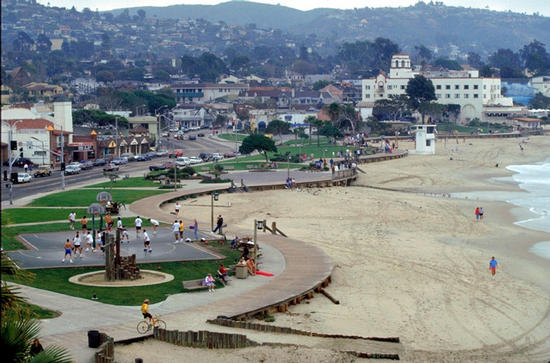 Laguna Beach: Multi-use path, sports court, and landscaped area between the beach and adjacent roadway and sidewalk.
Laguna Beach: Multi-use path, sports court, and landscaped area between the beach and adjacent roadway and sidewalk.
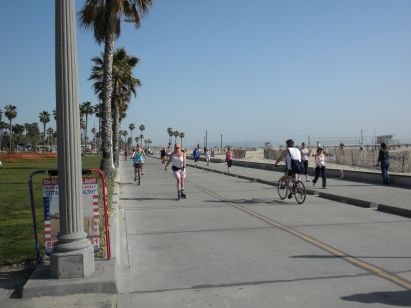 Santa Monica: Separate bike path and pedestrian walkway separated by a barrier and flanked by the beach on one side and parkland on the other.
Santa Monica: Separate bike path and pedestrian walkway separated by a barrier and flanked by the beach on one side and parkland on the other.
 Manhattan Beach: Pedestrian walkway (upper level), which is separated from a bike path, below, by “water wise” landscaping with the beach beyond.
Manhattan Beach: Pedestrian walkway (upper level), which is separated from a bike path, below, by “water wise” landscaping with the beach beyond.
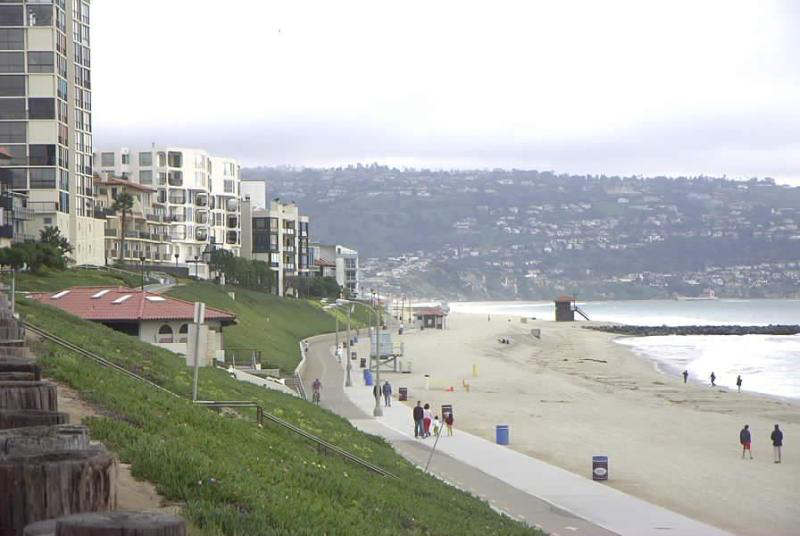 Redondo Beach: Separate bike path and pedestrian walkway, which are differentiated by different types of pavement.
Redondo Beach: Separate bike path and pedestrian walkway, which are differentiated by different types of pavement.
 Redondo Beach: Another picture of the separate bike path and pedestrian walkway, which shows the markings on the pavement indicating the walkway is only for pedestrians and that bikes must be “walked” on it.
Redondo Beach: Another picture of the separate bike path and pedestrian walkway, which shows the markings on the pavement indicating the walkway is only for pedestrians and that bikes must be “walked” on it.
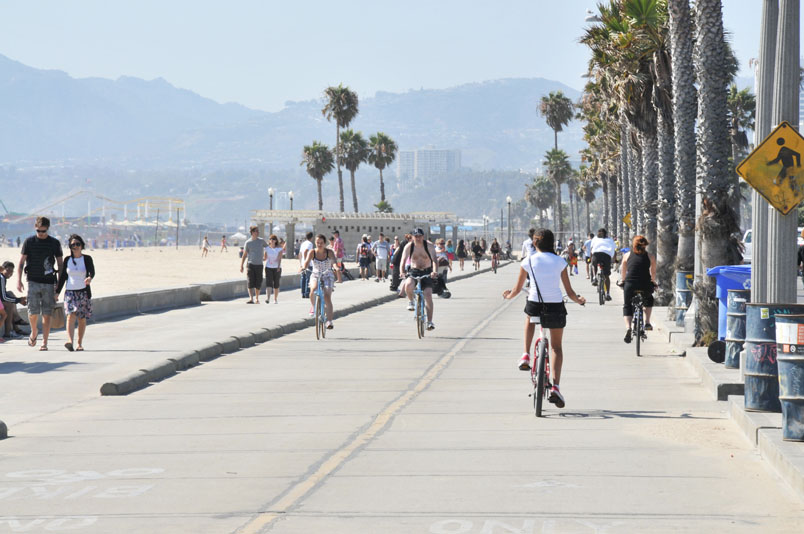 Venice Beach: Separate bike path and pedestrian walkway with painted markings that indicate the path is for the exclusive use of bicyclists and a marked crosswalk for pedestrians.
Venice Beach: Separate bike path and pedestrian walkway with painted markings that indicate the path is for the exclusive use of bicyclists and a marked crosswalk for pedestrians.
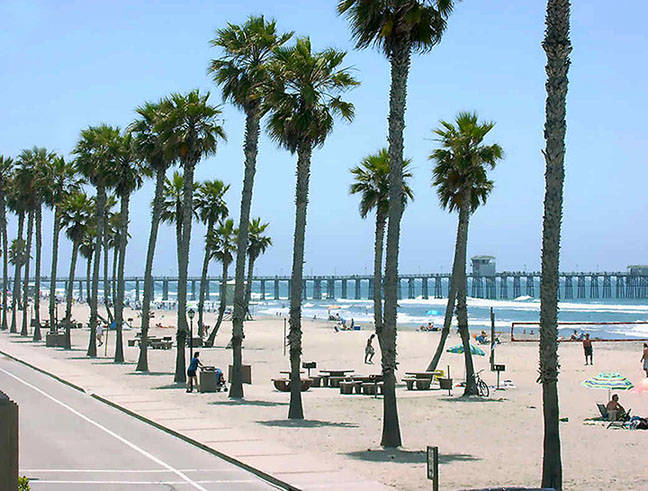 Oceanside: Photo highlighting palm-lined sidewalk and adjacent street, which is closed to vehicular traffic, adjacent to beach with picnic tables and other amenities.
Oceanside: Photo highlighting palm-lined sidewalk and adjacent street, which is closed to vehicular traffic, adjacent to beach with picnic tables and other amenities.
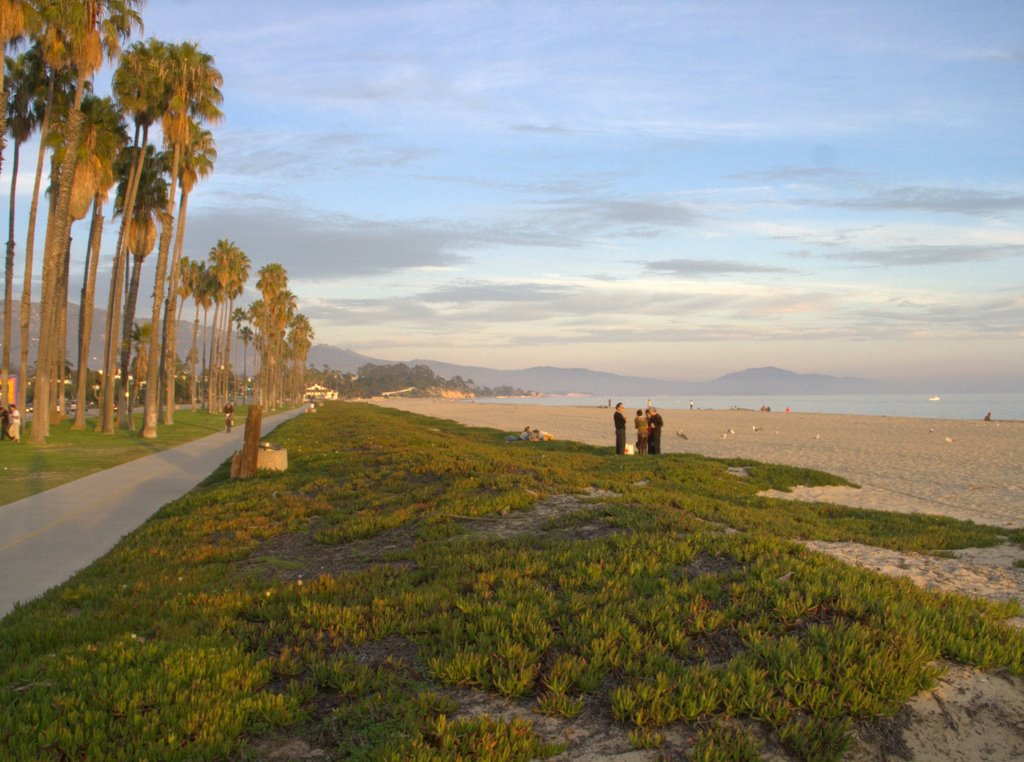 Santa Barbara: Bike path flanked by a grove of palm trees with a sidewalk and road beyond and overlooking the beach.
Santa Barbara: Bike path flanked by a grove of palm trees with a sidewalk and road beyond and overlooking the beach.
John Tato
Staff Writer




